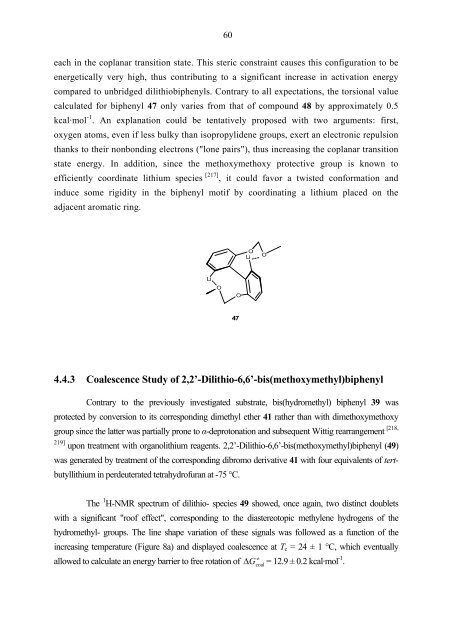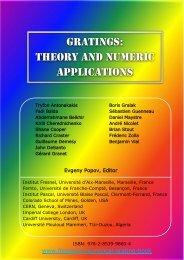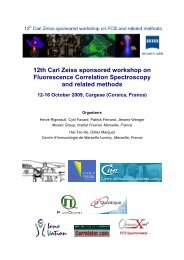My PhD dissertation - Institut Fresnel
My PhD dissertation - Institut Fresnel
My PhD dissertation - Institut Fresnel
Create successful ePaper yourself
Turn your PDF publications into a flip-book with our unique Google optimized e-Paper software.
60<br />
each in the coplanar transition state. This steric constraint causes this configuration to be<br />
energetically very high, thus contributing to a significant increase in activation energy<br />
compared to unbridged dilithiobiphenyls. Contrary to all expectations, the torsional value<br />
calculated for biphenyl 47 only varies from that of compound 48 by approximately 0.5<br />
kcal·mol -1 . An explanation could be tentatively proposed with two arguments: first,<br />
oxygen atoms, even if less bulky than isopropylidene groups, exert an electronic repulsion<br />
thanks to their nonbonding electrons ("lone pairs"), thus increasing the coplanar transition<br />
state energy. In addition, since the methoxymethoxy protective group is known to<br />
efficiently coordinate lithium species<br />
[ ] 217 , it could favor a twisted conformation and<br />
induce some rigidity in the biphenyl motif by coordinating a lithium placed on the<br />
adjacent aromatic ring.<br />
Li<br />
O<br />
O<br />
47<br />
O<br />
Li<br />
O<br />
4.4.3 Coalescence Study of 2,2’-Dilithio-6,6’-bis(methoxymethyl)biphenyl<br />
Contrary to the previously investigated substrate, bis(hydromethyl) biphenyl 39 was<br />
protected by conversion to its corresponding dimethyl ether 41 rather than with dimethoxymethoxy<br />
group since the latter was partially prone to α-deprotonation and subsequent Wittig rearrangement<br />
219 ]<br />
upon treatment with organolithium reagents. 2,2’-Dilithio-6,6’-bis(methoxymethyl)biphenyl (49)<br />
was generated by treatment of the corresponding dibromo derivative 41 with four equivalents of tert-<br />
butyllithium in perdeuterated tetrahydrofuran at -75 °C.<br />
The 1 H-NMR spectrum of dilithio- species 49 showed, once again, two distinct doublets<br />
with a significant "roof effect", corresponding to the diastereotopic methylene hydrogens of the<br />
hydromethyl- groups. The line shape variation of these signals was followed as a function of the<br />
increasing temperature (Figure 8a) and displayed coalescence at Tc = 24 ± 1 °C, which eventually<br />
≠<br />
allowed to calculate an energy barrier to free rotation of G = 12.9 ± 0.2 kcal·mol<br />
∆ coal<br />
-1 .<br />
[ 218,













